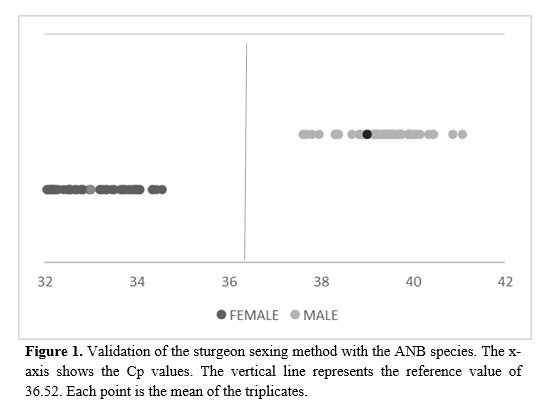A NOVEL METHOD FOR STURGEON SEXING BASED ON REAL TIME PCR
Introduction
The sturgeon is known as a ‘living fossil’, estimated to have existed for more than 250 million years, and is known primarily for its eggs, which are used to produce caviar, although its meat is also eaten. Virtually all caviar marketed today can be considered to come from aquaculture (EUMOFA, 2021). There are 25 sturgeon species belonging to the family Acipenseridae, among which the best known and most appreciated species belong to the genus Huso and Acipenser, the latter including the largest number of species.
At present, cytogenetical studies have not revealed any presence of sex heteromorphic chromosomes in sturgeons (Havelka et al., 2011). Due to their lack of secondary sexual characteristics, sturgeon sexing cannot be directly distinguished by their appearance.
It is noteworthy that caviar results from the processing of sturgeon eggs, so therefore requires the rearing of female fish. Thus, exploitation of sturgeons is highly costly, as females take many years to reach reproductive maturity. In fact, the process of selecting females for caviar production can be done after an average of 8 years of rearing, depending on the species, through an ultrasound examination to differentiate between male and female sturgeons. During this period, it is necessary to breed both males and females, with the consequent production (EUMOFA, 2021).
In recent years, new sex identification methods of sturgeons are based on specific genes or molecular markers. For example, it has been reported the amplification by PCR of the specific molecular marker fragments of sturgeon, and the subsequently detection of amplified fragments by gel agarose electrophoresis, for sex identification (Kuhl et al., 2021; Ruan et al., 2021). However, this methodology cannot meet the needs of current gender identification of sturgeons for the lack of accuracy and reproducibility.
For this reason, the industry needs accurate and robust sexing systems for sturgeon at an early age to adapt the feeding and needs of the animals as early as possible to optimise the maturation of the females and the final production of caviar.
Material and Methods
Reference tissue samples of 296 adult sturgeons (Acipenser baerii, A. gueldenstaedtii, A. naccarii and A. naccarii x A. baerii (ANB)), were taken and stored at -20 °C until use. DNA extraction is performed using Wizard® Genomic DNA Purification Kit. All adults were previously sexed by visualization of the gonads (ovaries or testes) by ultrasounds in the facilities of Caviar Riofrío (Granada, Spain).
The amplification and detection of a 65 bp sex specific fragment is carried out by real time PCR amplification. Amplification is performed in MicroAmp Optical 96-well reaction plate. Each reaction mixture contained 0.3 μM of each forward and reverse primer*, 2.5 μM of specific FAM labeled probe* and 1-10 ng of template DNA. Amplification reactions are carried out employing TaqManTM Universal Master Mix (Applied Biosystems, Thermo Fisher Scientific, USA). The analysis was carried out using the fluorescent signal level during the initial cycles of PCR. This baseline is used to accurately determine crossing point (Cp). Every sample is analyzed by triplicates and the average Cp is calculated for each sample.
* Primer and probe sequences are patent pending
Results and Conclusions
In the case of ANB species and after analyzing, at least, 50 male and 50 females, the real time PCR method has a 97,41 % correct male assignment (Figure 1). In other species, by far, the correct assignment is 100 % but, in the near future, a higher number of individuals are required to finish the complete validation with more sturgeon species.
In conclusion, the real time PCR method is suitable for sturgeon sexing of the most important commercial species. This molecular method has proven to be very accurate and reliable in comparison to other molecular methods previously described, holding the potential to become a routine methodology.
Acknowledgments
Reference samples were kindly provided by Caviar Riofrio (Granada, Spain)
*Primer and probe sequences are patent pending
References
EUMOFA. (2021). The caviar market. Production, trade, and consumption in and outside the EU: an update of the 2018-report. . Publications Office of the European Union(May), 1-38.
Havelka, M., Kašpar, V., Hulák, M., & Flajšhans, M. (2011). Sturgeon genetics and cytogenetics: a review related to ploidy levels and interspecific hybridization. Folia Zoologica, 60(2), 93-103. https://doi.org/10.25225/fozo.v60.i2.a3.2011
Kuhl, H., Guiguen, Y., Höhne, C., Kreuz, E., Du, K., Klopp, C., Lopez-Roques, C., Yebra-Pimentel, E. S., Ciorpac, M., Gessner, J., Holostenco, D., Kleiner, W., Kohlmann, K., Lamatsch, D. K., Prokopov, D., Bestin, A., Bonpunt, E., Debeuf, B., Haffray, P., . . . Stöck, M. (2021). A 180 Myr-old female-specific genome region in sturgeon reveals the oldest known vertebrate sex determining system with undifferentiated sex chromosomes. Phil. Trans. R. Soc. B, 376(20200089). https://doi.org/10.1098/rstb.2020.0089
Ruan, R., Feng, T., Li, Y., Yue, H., Ye, H., Du, H., Liu, Q., Ruan, J., Li, C., & Wei, Q. (2021). Screening and identification of female-specific DNA sequences in octaploid sturgeon using comparative genomics with high-throughput sequencing [Research Support, Non-U.S. Gov’t]. Genomics, 113(6), 4237-4244. https://doi.org/10.1016/j.ygeno.2021.11.012
